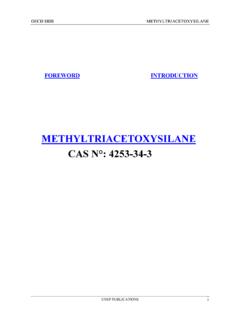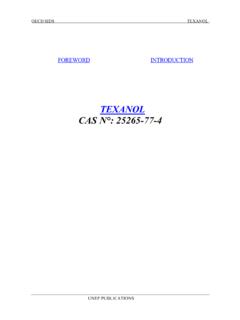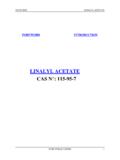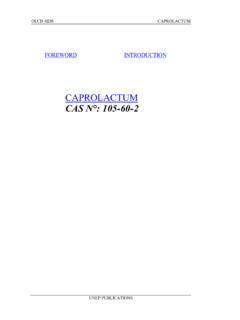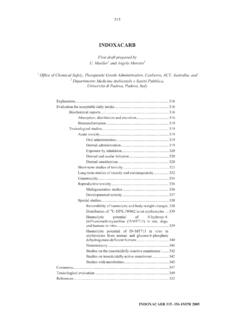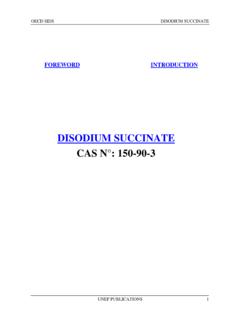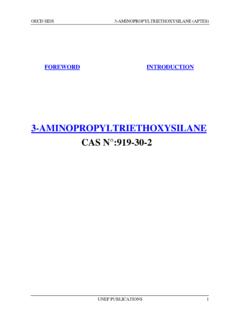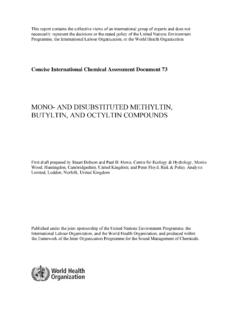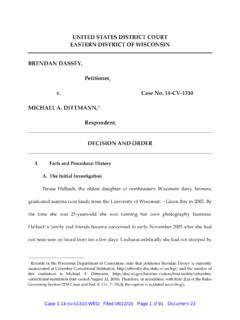Transcription of SODIUMHYDROXIDE CAS N°: 1310-73-2 - inchem.org
1 OECD SIDS SODIUM HYDROXIDE. FOREWORD INTRODUCTION. SODIUM HYDROXIDE. CAS N : 1310-73-2 . UNEP PUBLICATIONS 1. OECD SIDS SODIUM HYDROXIDE. SIDS Initial Assessment Report For SIAM 14. Paris, 26-28 March 2002. 1. Chemical Name: Sodium hydroxide 2. CAS Number: 1310-73-2 . 3. Sponsor Country: Portugal 4. Shared Partnership with: -- 5. Roles/Responsibilities of -- the Partners: Name of industry sponsor Solvay, Belgium /consortium Process used -- 6. Sponsorship History The documents were prepared through the ICCA initiative (Solvay) and reviewed by the Portuguese authorities. How was the chemical or -- category brought into the OECD HPV Chemicals Programme? 7. Review Process Prior to -- the SIAM: 8. Quality check process: -- 9. Date of Submission: -- : -- 2 UNEP PUBLICATIONS. OECD SIDS SODIUM HYDROXIDE. SIDS INITIAL ASSESSMENT PROFILE. CAS No. 1310-73-2 . Chemical Name Sodium hydroxide Structural Formula NaOH.
2 RECOMMENDATIONS. The chemical is currently of low priority for further work. SUMMARY CONCLUSIONS OF THE SIAR. Human Health Solid NaOH is corrosive. Depending on the concentration, solutions of NaOH are non-irritating, irritating or corrosive and they cause direct local effects on the skin, eyes and gastrointestinal tracts. Based on human data concentrations of % were irritating to the skin, while a concentration of % was corrosive for the skin of animals. Eye irritation data are available for animals. The non-irritant level was %, while the corrosive concentration was % or higher. A study with human volunteers did not indicate a skin sensitisation potential of sodium hydroxide. This is supported by the extensive human experience. The acute toxicity of sodium hydroxide depends on the physical form (solid or solution), the concentration and dose. Lethality has been reported for animals at oral doses of 240 and 400 mg/kg bw.
3 Fatal ingestion and fatal dermal exposure has been reported for humans. No valid animal data are available on repeated dose toxicity studies by oral, dermal, inhalation or by other routes for NaOH. However, under normal handling and use conditions (non-irritating) neither the concentration of sodium in the blood nor the pH of the blood will be increased and therefore NaOH is not expected to be systemically available in the body. It can be stated that the substance will neither reach the foetus nor reach male and female reproductive organs, which shows that there is no risk for developmental toxicity and no risk for toxicity to reproduction. Both in vitro and in vivo genetic toxicity tests indicated no evidence for a mutagenic activity. Based on the available literature, there is a risk for accidental and intentional exposure to solid NaOH or to irritating or corrosive solutions of NaOH.
4 Most of the ingestion accidents seem to be related with children and seem to occur at home. Accidental skin and eye exposure seem to be less frequently reported than ingestion in the medical literature. Dust formation is unlikely because of hygroscopic properties. Furthermore NaOH has a negligible vapour pressure and is rapidly neutralized in air by carbon dioxide and therefore dust and vapour exposure are not expected. Environment The hazard of NaOH for the environment is caused by the hydroxyl ion (pH effect). For this reason the effect of NaOH on the organisms depends on the buffer capacity of the aquatic or terrestrial ecosystem. Also the variation in acute toxicity for aquatic organisms can be explained for a significant extent by the variation in buffer capacity of the test medium. LC50 values of acute toxicity tests with aquatic organisms ranged between 33 and 189 mg/l.
5 Because the buffer capacity, the pH and the fluctuation of the pH are very specific for a certain ecosystem it was not considered useful to derive a PNEC or a PNEC added. To assess the potential environmental effect of an NaOH. discharge, the pH change of the receiving water should be calculated or measured. The change in pH should be compared with the natural variation in pH of the receiving water and based on this comparison t should be assessed UNEP PUBLICATIONS 3. OECD SIDS SODIUM HYDROXIDE. if the pH change is acceptable. The use of NaOH could potentially result in an emission of NaOH and it could locally increase the pH in the aquatic environment. However, the pH of effluents is normally measured very frequently and can be adapted easily and therefore a significant increase of the pH of the receiving water is not expected. If emissions of waste water are controlled by appropriate pH limits and/or dilutions in relation to the natural pH and buffering capacity of the receiving water, adverse effects on the aquatic environment are not expected due to production or use of NaOH.
6 Aquatic sodium emissions originating from uses of NaOH are probably small compared to other sources. It is clear that an environmental hazard assessment of sodium should not only evaluate all natural and anthropogenic sources of sodium but should also evaluate all other ecotoxicity studies with sodium salts, which is beyond the scope of this report. Exposure Estimated worldwide demand of sodium hydroxide was 44 million tonnes expressed as NaOH 100% in 1999. The global demand is expected to grow with per year. NaOH is commercialised as a solid or as solutions with varying concentrations. NaOH solidifies at 20 C if the concentration is higher than 52 % (by weight), which can be considered the maximum water solubility at 20 C. NaOH has many industrial uses but it has also wide dispersive use. It is used for example for cleaning, disinfection, wood treatment and to make soap at home, but many ot her uses could exist.
7 NATURE OF FURTHER WORK RECOMMENDED. Environment and human health: no further work is recommended if sufficient control measures are in place to avoid significant human and environmental impact, including prevention of accidental exposure. Due to the corrosivity of the substance, no further studies are required under the SIDS programme. In the EU a risk assessment will be performed according to Council Regulation 793/93. 4 UNEP PUBLICATIONS. OECD SIDS SODIUM HYDROXIDE. FULL SIDS SUMMARY. CAS N 1310-73-2 SPECIES PROTOCOL RESULTS. PHYSICO-CHEMICAL. Melting point Data of Oxychem 318 C (solid, 100 %). Caustic Soda 140 C (solution of 80 %). Handbook 42 C (solution of 60 %). 16 C (solution of 40 %). -26 C (solution of 20 %). Boiling point Data of Oxychem 1388 C at 1013 hPa (solid, 100 %). Caustic Soda 216 C at 1013 hPa (solution of 80 %). Handbook 160 C at 1013 hPa (solution of 60 %).
8 128 C at 1013 hPa (solution of 40 %). 118 C at 1013 hPa (solution of 20 %). Density Data of Oxychem at 20 C (solid, 100 %). Caustic Soda at 20 C (solution of 40 %). Handbook at 20 C (solution of 20 %). Vapour pressure Data of Oxychem 55 hPa at 1000 C. Caustic Soda < 10-5 hPa at 25 C (calculation). Handbook Partition coefficient Not relevant for ionisable compounds Water solubility Miscible at all proportions. Oxidising properties Not applicable Additional remarks Vigorous exothermic reaction when sodium hydroxide is added to water. ENVIRONMENTAL FATE AND. PATHWAY. Photodegr adation Not applicable Stability in water Strong alkaline substances that dissociates fully. The concentration of OH- (pH). is in general regulated by the equilibria between CO2, HCO3- and CO32-. In general the buffer capacity depends on the concentration of these substances. Monitoring data The pH has been monitored very extensively in ecosystems.
9 Significant differences in concentrations between ecosystems occur. The most important freshwater aquatic ecosystems of the world revealed average annual pH values between and (UNEP, 1995). Also sodium has been measured extensively in aquatic ecosystems. For example UNEP (1995) reported the concentration for a total number of 75 rivers in North- America, South-America, Asia, Africa, Europe and Oceania. The 10th . percentile, mean and 90th-percentile were , 28 and 68 mg/l, respectively. Transport and Distribution Very mobile in soil and very soluble in water. No transport to air. Biodegradation Not applicable ECOTOXICOLOGY. Acute/prolonged toxicity to Ceriodaphnia sp.: EC50 = 40 mg/l (Warne et al., 1999). fish No other valid studies available. The hazard of NaOH for the environment is Acute toxicity to aquatic caused by the hydroxyl ion (pH effect). For this reason the effect of NaOH on the invertebrates organisms depends on the buffer capacity of the aquatic or terrestrial ecosystem Toxicity to aquatic plants (see also ).
10 Also the variation in acute toxicity for aquatic organisms can be algae explained for a significant extent by the variation in buffer capacity of the test Toxicity to micro- medium. LC50 values ranged between 33 and 189 mg/l. organisms bacteria Chronic toxicity to fish Because the buffer capacity, pH and the fluctuation of the pH are very specific Chronic toxicity to aquatic for a certain ecosystem it was not considered useful to derive a PNEC. For this invertebrates reason there is no need for additional toxicity testing with NaOH. UNEP PUBLICATIONS 5. OECD SIDS SODIUM HYDROXIDE. CAS N 1310-73-2 SPECIES PROTOCOL RESULTS. TOXICOLOGY. Acute Oral No valid studies available. Although valid studies with animals are not available, Acute Inhalation intentional and accidental ingestion of NaOH by humans has been reported Acute Dermal frequently in the literature and for this reason there is no need for additional oral testing with animals.
